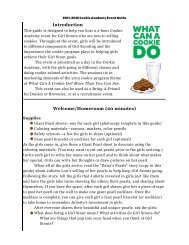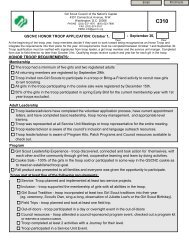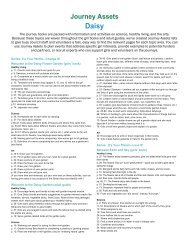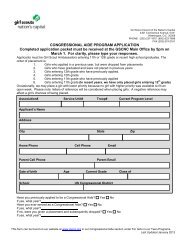Zoo Animal Safari - Girl Scout Council of the Nation's Capital
Zoo Animal Safari - Girl Scout Council of the Nation's Capital
Zoo Animal Safari - Girl Scout Council of the Nation's Capital
Create successful ePaper yourself
Turn your PDF publications into a flip-book with our unique Google optimized e-Paper software.
<strong>Girl</strong> <strong>Scout</strong> <strong>Council</strong> <strong>of</strong> <strong>the</strong> Nation’s <strong>Capital</strong><br />
Presents<br />
Hi! I’m ZAS.<br />
Come with me on a <strong>Zoo</strong> <strong>Animal</strong> <strong>Safari</strong> through <strong>the</strong><br />
National <strong>Zoo</strong>. Meet my neighbors and learn how we<br />
deal with conflict. Let us show you how to apply<br />
what you learn to your own life.
Welcome to <strong>Zoo</strong> <strong>Animal</strong> <strong>Safari</strong>.<br />
This program was updated in 2004, it was originally designed by<br />
Senior <strong>Girl</strong> <strong>Scout</strong>s to help <strong>Girl</strong> <strong>Scout</strong>s who visit <strong>the</strong> zoo identify<br />
conflict situations and ways to avoid <strong>the</strong>m. It was updated to<br />
reflect animals currently at <strong>the</strong> zoo, The program introduces <strong>the</strong>m<br />
to some <strong>of</strong> <strong>the</strong> animals at <strong>the</strong> National <strong>Zoo</strong> so that <strong>the</strong>y meet <strong>the</strong><br />
animals that <strong>the</strong>y learn about.<br />
This program provides an opportunity for elementary school age<br />
girls to think individually and as a group about how and when<br />
animal behavior can apply in <strong>the</strong>ir lives especially in conflict<br />
situations.<br />
<strong>Girl</strong> <strong>Scout</strong> <strong>Council</strong> <strong>of</strong> <strong>the</strong> Nation’s <strong>Capital</strong><br />
4301 Connecticut Avenue, NW Suite M-2<br />
Washington, DC 20008<br />
(202) 237-1670 or (800) 523-7898<br />
Fax: (202) 274-2161<br />
To order <strong>Zoo</strong> <strong>Animal</strong> <strong>Safari</strong> patches use <strong>the</strong> order form in <strong>the</strong> back <strong>of</strong> <strong>the</strong><br />
booklet. The patches cost $1.50. (Code 66900)<br />
ZOO ANIMAL SAFARI
This booklet will lead you on a safari through <strong>the</strong> National <strong>Zoo</strong>. You and your<br />
friends will identify several animals and <strong>the</strong>ir behavior. Certain characteristics are<br />
listed for each animal. You can encourage <strong>the</strong> girls to keep a look out for o<strong>the</strong>r<br />
animals that may display some <strong>of</strong> <strong>the</strong>se characteristics. There are Discovering<br />
Activities and Exploring Activities at each point on <strong>the</strong> safari. The discovery<br />
activities are related to <strong>the</strong> animals’ behavior and home at <strong>the</strong> zoo. The exploring<br />
activities will help you explore ways that <strong>the</strong> animal behavior relates to human<br />
behavior. At <strong>the</strong> same time you are meeting <strong>the</strong> animals you will be learning about<br />
<strong>the</strong>ir behavior. Feel free to explore <strong>the</strong> activities in each animal area.<br />
Requirements:<br />
The booklet identifies ten animals and <strong>the</strong>ir characteristics. To earn this patch<br />
please complete two Exploring Activities for at least seven animals.<br />
Leaders:<br />
Allow at least two and a half hours for <strong>the</strong> program and extra time on busy<br />
days for waiting to get into <strong>the</strong> reptile house or o<strong>the</strong>r exhibits housed in buildings.<br />
The patch program is organized beginning at <strong>the</strong> Connecticut Avenue entrance.<br />
However, you may choose to complete <strong>the</strong> booklet in any order.<br />
Please feel free to facilitate <strong>the</strong> questions and activities anyway you would like. You<br />
may find that <strong>the</strong> girls will need very little prompting after you have gone through a<br />
couple <strong>of</strong> <strong>the</strong> animals. If <strong>the</strong> children want to stay and observe animals, more time<br />
will be necessary, but it may be better for girls to do <strong>the</strong> program at <strong>the</strong>ir pace than to<br />
be rushed. When doing <strong>the</strong> program, each child should have her own worksheet with<br />
<strong>the</strong> booklet designed for <strong>the</strong> group leader.<br />
Where <strong>the</strong> activities ask for role-plays, ideally it should be done at <strong>the</strong> zoo if <strong>the</strong>re is<br />
time. There are numerous grassy spaces around <strong>the</strong> zoo, in which to sit and chat.<br />
However if you cannot do this at <strong>the</strong> zoo, <strong>the</strong>se can be acted out during <strong>the</strong> next<br />
meeting as a follow up activity to <strong>the</strong> zoo visit.<br />
Please note: The words that are in italics are in <strong>the</strong> glossary at <strong>the</strong> back <strong>of</strong> <strong>the</strong><br />
booklet.
1.<br />
CHEETAH<br />
Selected Characteristics: camouflage and reacting passively<br />
to a situation<br />
Find <strong>the</strong> cheetahs at <strong>the</strong> Cheetah Conservation Station located in<br />
<strong>the</strong> African Savanna.<br />
Cheetahs are calm and do not get angry easily. The design <strong>of</strong><br />
<strong>the</strong>ir coat makes <strong>the</strong>m blend into <strong>the</strong> grasslands. Camouflage can<br />
keep predators guessing how many are in <strong>the</strong> group and which are<br />
young or old. When confronted with danger, <strong>the</strong>ir ability to run<br />
very fast allows <strong>the</strong>m to get away. No matter how fast cheetahs<br />
go or how hard <strong>the</strong>y try, <strong>the</strong>y do not always catch <strong>the</strong>ir prey.<br />
Cheetahs use so much energy running fast that <strong>the</strong>y <strong>of</strong>ten do not<br />
have any energy left to fight for <strong>the</strong>ir food.<br />
Discovering Activity:<br />
a. Can you see <strong>the</strong> cheetahs easily?<br />
b. If you can see more than one cheetah, do <strong>the</strong>y look alike?<br />
Look closely at <strong>the</strong> tails. You can tell cheetahs apart by<br />
looking at <strong>the</strong> stripes on <strong>the</strong>ir tails. Every cheetah’s<br />
stripes are unique, just like every human’s fingerprints<br />
are unique.<br />
c. Around <strong>the</strong> zoo, look for o<strong>the</strong>r animals that use clever<br />
adaptations for camouflage or to handle stressful<br />
situations.<br />
Exploring Activities:<br />
a. Speed is <strong>the</strong> best protection for this animal. With your<br />
friends make a list <strong>of</strong> times you wanted to run away from a
problem. Would running away have helped <strong>the</strong> situation?<br />
Talk about when it is appropriate to run.<br />
b. The cheetah must constantly search for food, sometimes<br />
finding none. Share how you feel when you do not achieve<br />
your goal. Think <strong>of</strong> a time when you tried to reach a goal<br />
and were disappointed. Some examples might be when you<br />
learned to: tie your shoes, count money, or ride a bike.<br />
What determines whe<strong>the</strong>r or not you try again?<br />
c. This animal blends into <strong>the</strong> grasslands.<br />
When is it best to blend into <strong>the</strong> crowd?<br />
When is it best to dress so that you are different from<br />
everyone around you?<br />
d. Look at <strong>the</strong> three examples below. With your group, decide<br />
when it is appropriate to dress each way. How would you<br />
feel if you were dressed this way and everyone else was<br />
dressed differently?<br />
e. When people dress alike to blend in, can you still tell <strong>the</strong>m<br />
apart? How?
2.<br />
ELEPHANT<br />
Selected Characteristics: Being a group leader and<br />
importance <strong>of</strong> friends<br />
Find <strong>the</strong> elephants in <strong>the</strong> Elephant House or yard.<br />
All <strong>the</strong> adults in <strong>the</strong> herd are female. Adult males come into <strong>the</strong><br />
herd only a couple <strong>of</strong> times a year. By staying in a group, <strong>the</strong><br />
elephants are able to protect <strong>the</strong>ir young from predators. Even<br />
big cats are careful when <strong>the</strong>y approach <strong>the</strong> elephants because <strong>of</strong><br />
<strong>the</strong> elephants’ large size. Some <strong>of</strong> <strong>the</strong> elephants at <strong>the</strong> zoo weigh<br />
close to 6,000 pounds.<br />
The leader <strong>of</strong> <strong>the</strong> herd is called <strong>the</strong> matriarch. In <strong>the</strong> herd, at<br />
<strong>the</strong> zoo, <strong>the</strong> leader is <strong>the</strong> matriarch because she is <strong>the</strong> largest. In<br />
o<strong>the</strong>r herds she might be <strong>the</strong> oldest or largest.<br />
Discovering Activity:<br />
Can you identify <strong>the</strong> matriarch?<br />
Are all <strong>the</strong> elephants hanging around<br />
toge<strong>the</strong>r?
Exploring Activity:<br />
a. The elephant faces <strong>the</strong> world more safely in a group. With<br />
<strong>the</strong> members in your troop/group have everyone name at<br />
least one time when you faced an uncomfortable situation by<br />
yourself. Perhaps you had to talk in front <strong>of</strong> a group all by<br />
yourself. Describe your feelings.<br />
b. Have you faced similar situations in a group or with a friend?<br />
Describe how you felt <strong>the</strong>n.<br />
c. Do you feel safer in a large group? Why?<br />
d. Is it easier to do something by yourself or is it better to form<br />
a team? List times a task that would have been easier if you<br />
had someone helping you.
3.<br />
HIPPOPOTAMUS<br />
Selected Characteristics: standing ground and things are<br />
not always what <strong>the</strong>y seem<br />
Find <strong>the</strong> Pygmy and Nile hippopotamuses in <strong>the</strong> Elephant<br />
House.<br />
The hippopotamus relaxes in <strong>the</strong> water by day and grazes on<br />
land by night. Hippos are bulky, solid and look clumsy, but <strong>the</strong>y<br />
are really shaped to fit both <strong>the</strong>ir land and water habitats. Nile<br />
Hippopotamuses’ eyes, ears, and nostrils sit atop <strong>the</strong>ir heads and<br />
close when <strong>the</strong>y go underwater. Hippos vary from brown to<br />
grayish purple, with pink under parts and skin creases. Their<br />
skin is very thick and is protected by a red or white excretion<br />
that serves as sunscreen, moisturizer and probably as a<br />
disinfectant. Hippos are virtually hairless, with bristles only on<br />
<strong>the</strong>ir noses, ears, and tail. Hippos' habit <strong>of</strong> resting in water<br />
during <strong>the</strong> day reduces energy and food demands, but <strong>the</strong> Nile<br />
Hippopotamus still requires 40 pounds <strong>of</strong> hay daily.<br />
In 1927 Harvey Firestone (who owned a large rubber<br />
plantation in Liberia) gave President Calvin Coolidge a male<br />
pygmy hippo named Billy as a gift. Billy is <strong>the</strong> ancestor to<br />
almost all pygmy hippos living in American zoos.
Discovering Activity:<br />
What sizes are <strong>the</strong> hippopotamuses?<br />
Are <strong>the</strong> hippos in <strong>the</strong> water or on land?<br />
Exploring Activities:<br />
a. While Nile hippos are usually sluggish on land, <strong>the</strong>y can<br />
gallop at speeds up to 30 miles per hour. Underwater, <strong>the</strong>y<br />
are graceful, "galloping" and walking on river or lake<br />
bottoms. Although pygmy hippopotamuses look relatively<br />
small and peaceful, <strong>the</strong>y can be extremely aggressive when<br />
it comes to protecting <strong>the</strong>ir home or enclosure. Have you<br />
ever made a decision about a person by looking only at<br />
<strong>the</strong>ir appearance? How <strong>of</strong>ten were you wrong about that<br />
decision? How did you feel later when you got to know <strong>the</strong><br />
person?<br />
b. Because males pose a threat to youngsters with <strong>the</strong>ir long<br />
teeth, female hippopotamuses attack males that wander too<br />
close. If a female begins to attack a male, he lies down to<br />
show that he means no harm. Do you sometimes find it is<br />
difficult to stand up for yourself? Have you ever<br />
compromised what you stand for?<br />
c. Can you think <strong>of</strong> ways people might be disappointed by<br />
<strong>the</strong>ir decisions? Make a list <strong>of</strong> three things you need to<br />
think about before making a decision.
4.<br />
APES<br />
Selected Characteristics: looks can be deceiving and<br />
understanding differences<br />
Find <strong>the</strong> apes and o<strong>the</strong>r primates at <strong>the</strong> Great Ape House.<br />
Apes look mean and strong, but looks are deceiving. They are<br />
really shy. However, if an ape is scared, it will put on a show<br />
that is sure to scare away almost any intruder. Apes are gentle<br />
plant-eating animals and do not hurt o<strong>the</strong>r animals, except in<br />
self-defense. When <strong>the</strong>y approach ano<strong>the</strong>r, <strong>the</strong>y shake <strong>the</strong>ir<br />
head, which means that <strong>the</strong>y mean no harm. Apes feel<br />
threatened when someone stares at <strong>the</strong>m for any length <strong>of</strong> time.<br />
Fellow primates groom each o<strong>the</strong>r to demonstrate <strong>the</strong>ir care<br />
and to give <strong>the</strong>m a sense <strong>of</strong> belonging. The entire group <strong>of</strong> adult<br />
apes helps with <strong>the</strong> discipline <strong>of</strong> all <strong>the</strong> youngsters. The apes try<br />
to train <strong>the</strong>ir youngsters to be better adults by teaching <strong>the</strong>m<br />
how to behave. When <strong>the</strong> youngsters in <strong>the</strong> group play hard<br />
and misbehave, an adult may have to discipline <strong>the</strong>m by giving<br />
<strong>the</strong>m a bite on <strong>the</strong> hand. They usually learn not to repeat that<br />
behavior.<br />
Discovering Activity:
Look at <strong>the</strong> different sizes <strong>of</strong> <strong>the</strong> primates in <strong>the</strong> great<br />
Ape House.<br />
What three different things do you see <strong>the</strong> primates<br />
doing?<br />
Exploring Activities:<br />
a. See if you can make friends with <strong>the</strong>se animals. Allow apes<br />
to get used to you by standing away from <strong>the</strong> glass. Before<br />
going closer to <strong>the</strong> glass, turn around and walk up<br />
backwards. Then sit down and look at something colorfulmaybe<br />
a map. If <strong>the</strong>re are no crowds around, <strong>the</strong> animals<br />
may come over to see what has captured your attention.<br />
Look at <strong>the</strong>m over your shoulder to be non-threatening. Be<br />
patient. It takes time to make friends.<br />
b. How do you feel when someone is staring at you? Do you<br />
feel uncomfortable?<br />
c. The National <strong>Zoo</strong> is home to many primate species.<br />
Orangutans and western lowland gorillas can be found at<br />
<strong>the</strong> Great Ape House. Orangs can also be seen at Think<br />
Tank. Smaller primates, can be found in <strong>the</strong> Small<br />
Mammal House. Look for gibbons at Gibbon Ridge and<br />
lemurs at Lemur Island. How are <strong>the</strong> actions <strong>of</strong> apes,<br />
chimpanzees and baboons similar and how are <strong>the</strong>y<br />
different? Do you think <strong>the</strong>y talk to each o<strong>the</strong>r? Do you think<br />
<strong>the</strong>y speak <strong>the</strong> same language?
d. With your group, discuss how you might meet someone <strong>of</strong> a<br />
culture different from yours or someone who speaks a<br />
language different from yours. <strong>Animal</strong>s also demonstrate<br />
different behaviors. Apes like to groom each o<strong>the</strong>r. Most<br />
insects make sounds by rubbing body parts (for example<br />
crickets). Some humans hug, kiss or shake hands when<br />
<strong>the</strong>y see each o<strong>the</strong>r. Talk about why it is important to learn<br />
<strong>the</strong> customs <strong>of</strong> cultures o<strong>the</strong>r than your own.<br />
e. Try <strong>the</strong> game “Back to Back.” Sit back to back with a<br />
partner. See if you can get your partner to draw exactly what<br />
you have drawn, using only words. Do not peek at what your<br />
partner is drawing. After taking turns giving directions,<br />
compare each set <strong>of</strong> drawings. Check <strong>the</strong> size, location on<br />
<strong>the</strong> page as well as details <strong>of</strong> how it is drawn. Decide what<br />
you could have said to make <strong>the</strong> drawings more alike. Were<br />
you frustrated if you didn’t understand? Why is good<br />
communication important?
5.<br />
SNAKES<br />
Selected Characteristics: protection by posturing and<br />
displaying confidence<br />
Find <strong>the</strong> snakes at <strong>the</strong> Reptile Discovery Center, located on<br />
Olmsted Walk between <strong>the</strong> Great Ape House and <strong>the</strong> Think<br />
Tank.<br />
Some people incorrectly believe that snakes live forever<br />
because <strong>the</strong>y shed <strong>the</strong>ir skin. Snakes usually shed <strong>the</strong>ir skin as<br />
part <strong>of</strong> <strong>the</strong> growing process. They live in hollow logs and in <strong>the</strong><br />
ground. Snakes are cold blooded or ecto<strong>the</strong>rmic, which means<br />
<strong>the</strong>y depend on external sources, such as <strong>the</strong> sun, to maintain<br />
<strong>the</strong>ir body temperature. They are also different from o<strong>the</strong>r<br />
animals, because <strong>the</strong>y smell with <strong>the</strong>ir tongue.<br />
Snakes all have different ways <strong>of</strong> handling predators. Some,<br />
scare animals by wiggling <strong>the</strong>ir tails and o<strong>the</strong>rs coil <strong>the</strong>ir bodies<br />
and vibrate <strong>the</strong>ir tails in dead leaves to simulate a rattle. If<br />
provoked, some will strike. A couple <strong>of</strong> snakes produce a yucky<br />
smell and release it on predators if <strong>the</strong>y are picked up. The<br />
smell acts as a deterrent. O<strong>the</strong>r snakes try to convince predators<br />
that <strong>the</strong>y are threatening, by rearing <strong>the</strong>ir head up and puffing out<br />
<strong>the</strong>ir throat.<br />
Discovering Activity:
Look for snakes displaying traits that make <strong>the</strong>m seem<br />
frightening or powerful.<br />
Exploring Activities:<br />
a. Think <strong>of</strong> some television characters that are able to show<br />
confidence and power when, really, deep inside, <strong>the</strong>y were<br />
scared. What do <strong>the</strong>y do to express this coolness?<br />
b. Share times when you have acted bravely, although you were<br />
scared. How did you feel afterward?<br />
c. Get toge<strong>the</strong>r with a buddy and brainstorm situations where<br />
you would need to assert yourself. Come toge<strong>the</strong>r as a group<br />
and role-play at least one way <strong>of</strong> showing confidence.<br />
Remember to think <strong>of</strong> how you can show confidence with<br />
your body composure.<br />
d. Have you seen o<strong>the</strong>r animals using body posture or body<br />
language to communicate that <strong>the</strong>y are strong?<br />
e. One <strong>of</strong> <strong>the</strong> snakes featured at <strong>the</strong> zoo, is <strong>the</strong> cottonmouth.<br />
They are usually not aggressive and will not attack unless<br />
bo<strong>the</strong>red. One <strong>of</strong> <strong>the</strong>ir unique behaviors is <strong>the</strong>ir ability to<br />
stand <strong>the</strong>ir ground or show confidence. When really<br />
bo<strong>the</strong>red, a cottonmouth coils its body and threatens <strong>the</strong><br />
intruder with its mouth wide open and its fangs exposed,<br />
showing <strong>the</strong> white lining <strong>of</strong> its mouth. How do you show<br />
confidence?
6.<br />
LIONS and TIGERS<br />
Selected characteristics: being strong but not a bully<br />
See <strong>the</strong> lions and tigers in <strong>the</strong>ir outdoor habitats on Lion/Tiger<br />
Hill.<br />
Tigers are <strong>the</strong> biggest <strong>of</strong> <strong>the</strong> big cats and <strong>the</strong> most social. A<br />
lion's roar can be heard up to five miles away. Lions live in<br />
groups called prides, which may include from several to 40<br />
individuals.<br />
Tigers live in <strong>the</strong> jungles <strong>of</strong> Asia and are <strong>the</strong> only species <strong>of</strong><br />
cat that likes to swim. They would ra<strong>the</strong>r amuse <strong>the</strong>mselves<br />
swimming than killing. Tiger females do most <strong>of</strong> <strong>the</strong> hunting<br />
and usually hunt in pairs. They do not like to fight, though <strong>the</strong>y<br />
are very strong. Lions avoid situations that would make <strong>the</strong>m<br />
fight. They are not bullies. They kill only to protect <strong>the</strong>ir cubs<br />
and to get food. In <strong>the</strong> wild, lions face dangers including habitat<br />
loss and being hunted.<br />
Discovery Activity:<br />
Are <strong>the</strong>re tiger cubs? What does <strong>the</strong>ir play look like?<br />
Follow <strong>the</strong> Great Cats Trail and investigate <strong>the</strong> signs<br />
along <strong>the</strong> trail.<br />
Exploring Activities:
a. Looking at tigers you would think <strong>the</strong>y are bullies, because<br />
<strong>the</strong>y are make loud roars, and have a bright orange fur.<br />
While a tiger is strong and big, <strong>the</strong>y are not bullies. What<br />
do bullies look like?<br />
b. It is not okay to hurt ano<strong>the</strong>r person. The person being<br />
bullied needs to know that what one person says does not<br />
make it truth and that its not okay that <strong>the</strong>y are being hurt.<br />
A person that is angry or frustrated can express himself or<br />
herself in a non-violent manner. Bullies do not have to<br />
bully. Do you know any bullies at your school? How do<br />
<strong>the</strong>y make you feel? With your troop/group list three things<br />
bullies do that make you feel uncomfortable.<br />
c. How can you show that you are strong and an individual<br />
without being a bully?<br />
b. Tiger cubs do not learn to solve problems and get along<br />
by <strong>the</strong>mselves. Members <strong>of</strong> <strong>the</strong>ir pact collectively teach<br />
<strong>the</strong>m. What advice did you get from your friends? What<br />
can you teach o<strong>the</strong>rs?
7.<br />
BATS<br />
Key Characteristic: communication<br />
Check out <strong>the</strong> bats in <strong>the</strong> Bat cave located near <strong>the</strong> tigers.<br />
In <strong>the</strong> southwestern U.S., Mexican free-tailed bats roost<br />
toge<strong>the</strong>r in large numbers. A female bat has a way to find her<br />
young among thousands when she returns from hunting for food.<br />
Each mo<strong>the</strong>r actually locates her own baby through recognition<br />
<strong>of</strong> its scent and call. Bats are not blind and many can see very<br />
well. Insect-eating bats depend on sound and very good hearing<br />
to find food and to get around in <strong>the</strong> dark. These bats use<br />
echolocation, or radar, to find <strong>the</strong>ir food. A bat hears <strong>the</strong> echoes<br />
and its brain works out a sound picture <strong>of</strong> <strong>the</strong> object. It can tell if<br />
<strong>the</strong> object is prey or part <strong>of</strong> <strong>the</strong> landscape.<br />
While Westerners <strong>of</strong>ten fear and dislike bats, in China bats<br />
have long symbolized happiness, longevity, and wealth. About<br />
one-forth <strong>of</strong> all mammal species are bats, which live everywhere<br />
except for Polar Regions and a few remote islands and<br />
mountaintops. Bats play a very important role in controlling<br />
insect populations, pollinating flowers, and spreading seeds. A<br />
single little brown bat can catch 600 mosquitoes in just one<br />
hour.<br />
Discovering Activity:
The zoo is a great place to find examples <strong>of</strong> communication.<br />
As you walk through <strong>the</strong> zoo, see if you can do a scavenger hunt<br />
finding methods <strong>of</strong> communication that match with your five<br />
senses. For example where can you smell communication? When<br />
you go near <strong>the</strong> Big Cats exhibit, you may smell where <strong>the</strong> cats<br />
have marked <strong>the</strong>ir territory.<br />
Exploring Activities:<br />
a. Play <strong>the</strong> telephone game and try to pass a message as<br />
accurately and as quickly as you can. What happened?<br />
b. List five ways you and your friends can communicate<br />
better.<br />
c. What is body language? With a partner demonstrate how<br />
you show anger, fear and joy (without speaking or making<br />
noise.) Next time you see someone you know; try to read<br />
what <strong>the</strong>ir body language is trying to tell you about <strong>the</strong>m. Do<br />
<strong>the</strong>y seem confident, or nervous, or are thinking about<br />
something else.<br />
d. Some moths can hear <strong>the</strong> ultrasonic pulses <strong>of</strong> bats and will<br />
change <strong>the</strong>ir flight path or drop to <strong>the</strong> ground in order to<br />
not be captured. O<strong>the</strong>rs, like <strong>the</strong> Tiger moth, will click<br />
back to confuse bats into thinking <strong>the</strong>y are ano<strong>the</strong>r bat.<br />
What would happen if an animal didn’t give a clear<br />
message to ano<strong>the</strong>r animal? Why is clear communication<br />
important?
8.<br />
Two-Toed Sloth<br />
Key Characteristics: taking some time to relieve stress by<br />
lounging about<br />
Find <strong>the</strong> sloth in <strong>the</strong> jungles <strong>of</strong> <strong>the</strong> Amazon at <strong>the</strong> Amazonian<br />
and in <strong>the</strong> small mammal house.<br />
Two-toed sloths move in a very slow and deliberate<br />
fashion. Most <strong>of</strong> <strong>the</strong>ir life is spent high up in trees. They do<br />
not like violence but <strong>the</strong>y are capable <strong>of</strong> self defense. Sloths<br />
usually eat, sleep and even give birth while hanging from<br />
limbs. They are herbivore, eating very little o<strong>the</strong>r than leaves.<br />
The two-toed sloth is covered with long, usually pale graybrown<br />
fur (paler on <strong>the</strong> head) that takes on a greenish hue due<br />
to algae that lives on my hairs.<br />
Discovering Activity:<br />
Can you find <strong>the</strong> sloths while walking through <strong>the</strong><br />
Amazonian exhibit or <strong>the</strong> Small Mammal House?<br />
Do you see <strong>the</strong> sloth in a tree or on <strong>the</strong> ground?<br />
Exploring Activity:<br />
a. What causes stress in your life? In which situation is stress a<br />
good thing?
. Can stressful situations or people be avoided? For stress that<br />
cannot be avoided, is <strong>the</strong>re a new way you should handle<br />
those situations?<br />
c. Brainstorm some ways that you handle stress.<br />
d. The sloth does very little physical activity. It comes to <strong>the</strong><br />
ground only once a week. Sometimes we complain <strong>of</strong> being<br />
busy or too stressed. If you could have a whole day to do<br />
whatever you want, what would you do?<br />
9.<br />
BEARS<br />
Selected Characteristics: reacting to surprise<br />
Find <strong>the</strong> several types <strong>of</strong> bears around <strong>the</strong> National <strong>Zoo</strong>, <strong>the</strong><br />
Sloth Bear and <strong>the</strong> Spectacled Bear.<br />
Sloth bears are not sloths. They are bears that live on <strong>the</strong><br />
Indian subcontinent including <strong>the</strong> island <strong>of</strong> Sri Lanka. The<br />
spectacled bear is South America's only bear; it lives in <strong>the</strong><br />
Andes, in a variety <strong>of</strong> habitats.
Bears vary in size and color. After eating a big meal in <strong>the</strong><br />
fall, many sleep away <strong>the</strong> winter. Many people find bears<br />
chunky, lumbering, and cute. They are dangerous, however if<br />
people or o<strong>the</strong>r animals surprise <strong>the</strong>m, especially if <strong>the</strong>y are<br />
traveling with <strong>the</strong>ir cubs. They will do anything to protect <strong>the</strong><br />
cubs. If threatened, bears will stand on two legs, waving <strong>the</strong>ir<br />
clawed forepaws as weapons. Bears can be very dangerous to<br />
humans because <strong>the</strong>y do not see very well.<br />
Discovering Activity:<br />
Do <strong>the</strong> bears look cute and cuddly? Are <strong>the</strong>y bigger<br />
than you thought?<br />
What are <strong>the</strong> bears<br />
doing?<br />
Exploring Activity:<br />
a. Have you ever gotten a different reaction than you expected<br />
from an animal or a friend when you surprised <strong>the</strong>m? How<br />
did you calm <strong>the</strong>m down and show <strong>the</strong>m you did not mean<br />
to surprise or hurt <strong>the</strong>m?<br />
b. Have each member <strong>of</strong> your group tell <strong>of</strong> a time that <strong>the</strong>y<br />
were surprised and how <strong>the</strong>y reacted.<br />
c. Draw a picture <strong>of</strong> yourself reacting to a big surprise. What<br />
expression does your face show?
10.<br />
Golden Lion Tamarin Monkey<br />
Key Characteristic: endangered species and working with<br />
family<br />
Golden lion tamarin monkeys can be found at <strong>the</strong> Small<br />
Mammal House and several tamarins roam around in <strong>the</strong> zoo.<br />
The golden lion tamarin species is one <strong>of</strong> <strong>the</strong> world's most<br />
endangered species because humans have cut down <strong>the</strong> rain<br />
forests where <strong>the</strong>y live. Tamarins live in a family group made<br />
up <strong>of</strong> a mo<strong>the</strong>r, fa<strong>the</strong>r and siblings. Their family groups may<br />
live toge<strong>the</strong>r or individually, but <strong>the</strong>y always work toge<strong>the</strong>r.<br />
Golden lion tamarins are very gentle and <strong>the</strong>y communicate by<br />
making high-pitched clicking and squeaking noises. At <strong>the</strong><br />
National <strong>Zoo</strong>, when squirrels become a problem,<br />
Once, when <strong>the</strong> free ranging tamarins’ mo<strong>the</strong>r was injured,<br />
<strong>the</strong> zookeepers captured her to help her, but when <strong>the</strong>y drove<br />
away with her, <strong>the</strong> monkeys followed <strong>the</strong>m shrieking and<br />
screaming. They are very close and dependent, though you<br />
would not guess this when you see <strong>the</strong>m.<br />
The zoo's free-ranging tamarins are fitted with radio collars<br />
so scientists can track <strong>the</strong>m if <strong>the</strong>y are out <strong>of</strong> sight. If <strong>the</strong>y
wander too far, scientists can sound a recorded tamarin call,<br />
near <strong>the</strong> nest box to attract <strong>the</strong> monkeys back.<br />
Discovering Activity:<br />
When you see <strong>the</strong> monkeys, are <strong>the</strong>y toge<strong>the</strong>r or alone?<br />
What size are <strong>the</strong>y? Do <strong>the</strong>y look different than o<strong>the</strong>r<br />
monkeys?<br />
Exploring Activities:<br />
a. Pair up and talk about <strong>the</strong> following:<br />
How is your family like this animal family?<br />
What are <strong>the</strong> jobs in your family? Are <strong>the</strong>y <strong>the</strong><br />
same in your friends’ families?<br />
Are chores ever <strong>the</strong> reason for conflict?<br />
Do you feel that you help your family by doing<br />
your share <strong>of</strong> <strong>the</strong> chores?<br />
b. With your troop or group, make a list <strong>of</strong> <strong>the</strong> jobs you all do,<br />
<strong>the</strong>n make a list <strong>of</strong> things you could do.<br />
c. How are your friends like family?
Is your friend <strong>the</strong>re to comfort you when you are sad?<br />
Are you <strong>the</strong>re for her/him?<br />
Think <strong>of</strong> times that you have had arguments with<br />
friends. Did your friendship get better after <strong>the</strong><br />
argument or did you loose a friend?<br />
Decide in each situation, which was more important<br />
winning <strong>the</strong> argument or loosing <strong>the</strong> friend?<br />
d. Make a list <strong>of</strong> ways humans have aided in species becoming<br />
endangered. How can humans help fix <strong>the</strong> problem?<br />
GLOSSARY<br />
assert - To state or express positively; affirm: To defend or maintain<br />
consequence - result or outcome <strong>of</strong> your decision.
cultural - <strong>the</strong> ideas, skills, arts, tools, and way <strong>of</strong> life <strong>of</strong> a certain people in a certain time.<br />
deterrent- something that discouraging enemy attack<br />
desert - a dry sandy region with little or no plant life.<br />
discipline - to train in discipline or punish.<br />
ecto<strong>the</strong>rmic- depend on external sources, such as <strong>the</strong> sun, to maintain <strong>the</strong>ir body temperatures<br />
echolocation- determining <strong>the</strong> location <strong>of</strong> something by measuring <strong>the</strong> time it takes for an echo<br />
to<br />
return from it<br />
endangered- in danger <strong>of</strong> no longer existing<br />
groom- animals clean, brush and remove dirt and parasites from <strong>the</strong> skin, fur, or fea<strong>the</strong>rs <strong>of</strong><br />
ano<strong>the</strong>r animal.<br />
habitat- area or environment where an organism normally lives<br />
herbivore- an animal that feeds mostly on plants<br />
intimidate - to make afraid<br />
mammal - any animal with glands in <strong>the</strong> female that produce milk for feeding <strong>the</strong> young.<br />
mating - <strong>the</strong> reproduction <strong>of</strong> a species<br />
matriarch - a woman who is <strong>the</strong> head or ruler <strong>of</strong> her family or tribe.<br />
posturing - when animals try to convince o<strong>the</strong>r animals that <strong>the</strong>y are stronger, more fierce or bigger<br />
by <strong>the</strong> way <strong>the</strong>y appear.<br />
predator - animals who live by killing and eating o<strong>the</strong>r animals.<br />
prey - an animal hunted for food by ano<strong>the</strong>r animal.<br />
safari - a journey or voyage; a trip<br />
superior - higher in rank or position.<br />
species-<br />
individual or kind belonging to a biological group<br />
symbolized- Something that represents something else<br />
techniques - a way <strong>of</strong> using tools, materials, etc. and following rules in doing something.
temperaments-The manner <strong>of</strong> thinking, behaving, or reacting characteristic <strong>of</strong> a specific person.<br />
territorial boundaries- a separating line that marks <strong>the</strong> limit <strong>of</strong> an area <strong>of</strong> land in which animals<br />
claim as <strong>the</strong>ir domain.<br />
threatened - if conditions persist species will die out completely<br />
Did you know?<br />
Former Smithsonian Secretary, S.P. Langley,<br />
advocated <strong>the</strong> establishment <strong>of</strong> <strong>the</strong> National<br />
<strong>Zoo</strong> to serve as a "refuge for vanishing races <strong>of</strong><br />
<strong>the</strong> continent." In 1889 Congress obliged<br />
Langley with <strong>the</strong> establishment <strong>of</strong> <strong>the</strong> National<br />
<strong>Zoo</strong>. In 1891, several bison, as well as o<strong>the</strong>r<br />
North American mammals, were moved from<br />
<strong>the</strong> National Mall, to become <strong>the</strong> <strong>Zoo</strong>'s first<br />
residents.
Thank you for completing <strong>the</strong> <strong>Zoo</strong> <strong>Animal</strong> <strong>Safari</strong> Program.<br />
To order <strong>the</strong> patch, please complete <strong>the</strong> order form and mail along with a check to:<br />
GSCNC SHOP<br />
4301 Connecticut Ave NW * Washington, DC * 20008<br />
Name____________________________________________Phone#__________________________<br />
Address____________________________City___________________State_______Zip___________<br />
<strong>Zoo</strong> <strong>Safari</strong> Patch item #66900 @ $1.50ea<br />
# patches needed _________ X $1.50 =<br />
____________<br />
For orders <strong>of</strong> 1 – 20 patches please add $1.50 for Shipping: ____________<br />
Total Order: ____________<br />
Patches are also available by shopping in person at <strong>the</strong><br />
GS Main Shop, Mobile Shop or <strong>the</strong> Mini Shops.<br />
For more info or to place <strong>the</strong> order with a credit card please call 202-237-1670 x212
















